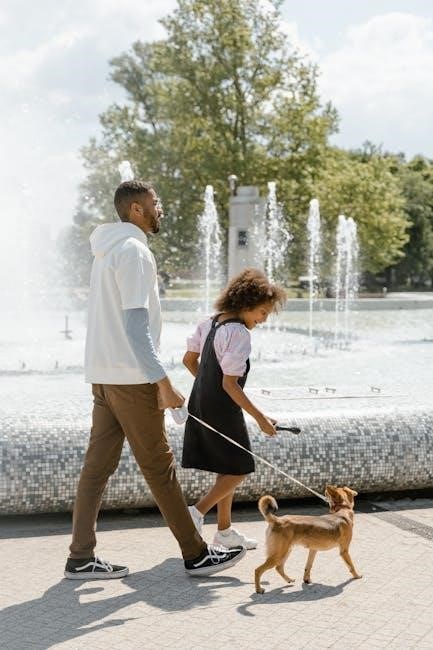The Gallery Walk Activity is a learner-centered approach fostering community and collaboration. It uses a worksheet to guide peer discussion, feedback, and reflection on displayed work.
1.1 What is a Gallery Walk Activity?
The Gallery Walk Activity is a collaborative learning strategy where students’ work is displayed for peers to review and discuss. It involves placing finished or in-progress work, such as posters, projects, or writings, around the classroom or designated area. Students then circulate, observe, and provide feedback using a structured worksheet. This activity encourages active participation, reflection, and engagement with diverse perspectives. It is often used across various subjects to promote a sense of community and foster meaningful interactions among learners; The worksheet serves as a guide, helping students focus their observations and responses, making the activity both organized and impactful.
1.2 Purpose of the Gallery Walk Activity
The purpose of the Gallery Walk Activity is to foster collaboration, discussion, and reflection among students. By displaying peers’ work, it encourages active participation and thoughtful engagement with diverse perspectives. The activity promotes a sense of community, allowing learners to share ideas and gain insights from one another. It also serves as a tool for formative assessment, enabling educators to gauge students’ understanding and progress. The structured worksheet guides students in providing constructive feedback, helping them develop critical thinking and communication skills. Ultimately, the Gallery Walk Activity creates an interactive and inclusive learning environment where students can learn from each other and grow academically and socially.

Educational Benefits of the Gallery Walk Activity
The Gallery Walk Activity fosters collaboration, community, and reflection. It encourages peer feedback, critical thinking, and engagement, promoting active learning and academic growth.
2.1 Promoting Collaboration and Community in the Classroom
The Gallery Walk Activity enhances collaboration by encouraging students to share ideas and learn from one another. Displaying work fosters a sense of community, as students engage with peers’ contributions. The worksheet guides thoughtful interaction, promoting mutual respect and teamwork. This approach breaks down classroom barriers, creating an inclusive environment where everyone’s voice is valued. By working together, students develop essential social skills and a deeper understanding of diverse perspectives. The activity strengthens class cohesion, making learning a shared and enriching experience for all participants.
2.2 Encouraging Student Discussion, Feedback, and Reflection
The Gallery Walk Activity fosters meaningful discussion by encouraging students to share insights and perspectives on displayed work. The worksheet serves as a tool to guide constructive feedback, helping students articulate their thoughts clearly. As they engage with peers’ contributions, students reflect on their own learning and gain new ideas. This interactive process promotes critical thinking and active listening, creating a dynamic learning environment. The activity also allows students to receive immediate feedback, enhancing their understanding and encouraging self-reflection. By participating in these exchanges, students develop communication skills and a deeper appreciation for diverse viewpoints, making the Gallery Walk a powerful tool for fostering engagement and growth.


How to Implement the Gallery Walk Activity
Implementing the Gallery Walk involves displaying student work, distributing worksheets, and guiding students to review and provide feedback on each piece, fostering collaboration and reflection.
3.1 Preparing for the Gallery Walk
Preparing for the Gallery Walk involves defining the activity’s purpose, whether to review work in progress or finished products. Create a worksheet to guide student feedback and reflection, ensuring it aligns with learning objectives. Arrange the classroom to display student work prominently, allowing easy access for movement. Distribute the worksheet and explain its use clearly. Encourage students to approach the activity thoughtfully and respectfully. Consider time management, allocating sufficient time for observation and response. Optional: Pair students or form small groups to facilitate collaboration. Ensure all materials, including the worksheet, are ready for distribution. This preparation ensures a smooth and productive activity.
3.2 Executing the Gallery Walk in the Classroom
During the Gallery Walk, students actively engage by moving around the classroom to observe and interact with displayed work. Each student uses the worksheet to record observations, answers to questions, or feedback for peers. Encourage thoughtful reflection and polite interaction. Allocate time for students to visit each station, ensuring they complete the worksheet thoroughly. Circulate the room to facilitate discussion, provide guidance, and address questions. Emphasize the importance of respecting peers’ work and contributing meaningful insights. After the activity, collect the worksheets to assess participation and understanding. This step fosters collaboration, critical thinking, and engagement, making the Gallery Walk a dynamic learning experience.
The Role of the Worksheet in the Gallery Walk
The worksheet serves as a structured guide, enabling students to engage deeply with peers’ work, reflect on their own learning, and provide constructive feedback effectively.
4.1 Understanding the Gallery Walk Worksheet (PDF)
The Gallery Walk Worksheet (PDF) is a structured guide designed to facilitate meaningful engagement during the activity. It typically includes directions, questions, and spaces for reflection, helping students focus on specific aspects of the work displayed. The worksheet often features a graphic organizer to prompt thoughtful analysis and encourage detailed feedback. By providing clear instructions, it ensures participants know how to navigate the activity, observe each piece, and record their insights. The PDF format makes it easy to distribute and use in various classroom settings, ensuring consistency and accessibility for all students. Its design supports active participation and deeper understanding of the material being explored.
4.2 How to Use the Worksheet Effectively
To use the Gallery Walk Worksheet effectively, begin by ensuring students understand its purpose and structure. Provide clear instructions on how to navigate the activity, such as allocating time for observation and reflection. Encourage students to move systematically through the displayed work, using the worksheet to guide their analysis. The graphic organizer within the worksheet can help students focus on specific aspects of each piece, such as key themes, questions, or contributions. Remind students to write thoughtful and polite feedback, fostering a respectful environment. Circulate the room to offer support and ensure active participation. The worksheet’s design makes it easy to use in various subjects and settings, promoting engagement and deeper understanding of the material. Consistency in its use enhances the overall learning experience.
Designing the Gallery Walk Worksheet
Designing the worksheet involves creating a structured format with clear instructions, questions, and space for feedback. It should be simple, visually appealing, and aligned with learning objectives.
5.1 Key Elements of the Worksheet
The Gallery Walk worksheet typically includes clear directions, specific questions, and space for feedback. It often features a graphic organizer to guide students in analyzing and reflecting on the work displayed. Key elements also include prompts that encourage thoughtful observation, such as describing, analyzing, and interpreting the content. Additionally, the worksheet may incorporate sections for peer feedback, allowing students to provide constructive comments. It is essential that the design is user-friendly, with ample space for writing and clear instructions to ensure students understand their tasks. These elements work together to facilitate meaningful engagement and learning during the activity.
5.2 Creating a Graphic Organizer for the Activity
A graphic organizer is a structured tool within the worksheet that helps students systematically analyze and reflect on the work displayed during the Gallery Walk. It typically includes sections for observation, analysis, and interpretation, with prompts or questions to guide students. The organizer may feature charts, tables, or concept maps to visually organize ideas. Clear instructions and examples are essential to ensure students understand how to use the organizer effectively. The design should be visually appealing and easy to navigate, with adequate space for writing. Including specific prompts related to the subject matter enhances focus and depth in student responses, making the activity more engaging and productive.

Examples of Gallery Walk Worksheets
Worksheets often include graphic organizers, charts, and reflection prompts. Examples range from historical analysis, like the Great Depression Gallery Walk, to STEM-related problem-solving activities.
6.1 Sample Gallery Walk Worksheets for Different Subjects
Sample worksheets are available for various subjects, such as history, STEM, and literature. For example, a history worksheet might include close-viewing exercises for historical images, while a STEM worksheet could focus on problem-solving questions related to scientific concepts. Literature-based worksheets often include reflection prompts for analyzing characters or themes. These examples demonstrate how the activity can be tailored to specific learning objectives, making it versatile for educators across disciplines. By providing structured yet adaptable templates, these samples help teachers implement the Gallery Walk effectively, ensuring students engage deeply with the material. This variety highlights the activity’s flexibility and its ability to enrich learning experiences across diverse subjects.
6.2 Customizing Worksheets for Specific Learning Objectives
Customizing worksheets for specific learning objectives ensures the activity aligns with curriculum goals; Educators can tailor questions, prompts, and graphic organizers to focus on particular skills or content. For instance, a STEM worksheet might emphasize data analysis, while a literature-focused sheet could target character analysis. By incorporating subject-specific language and tasks, teachers can deepen students’ understanding of key concepts. Additionally, worksheets can be adapted to accommodate different learning styles, such as including visual or textual prompts. This customization enhances engagement and ensures the activity meets the unique needs of the classroom. Examples from various subjects demonstrate how educators can modify worksheets to achieve targeted learning outcomes effectively.
Student Participation and Engagement
The Gallery Walk Activity fosters active student participation and engagement by encouraging collaboration and thoughtful interaction with peers’ work, guided by a structured worksheet.
7;1 Encouraging Active Participation in the Gallery Walk
Active participation in the Gallery Walk is fostered by clear instructions and structured tasks. Students are encouraged to engage thoughtfully with each display, using the worksheet to guide their observations and reflections. By providing specific questions or prompts, educators ensure that all students contribute meaningfully, fostering a sense of responsibility and collaboration. Positive reinforcement and open-ended discussions further motivate students to share their insights, creating a dynamic and inclusive learning environment. The worksheet serves as a tool to keep students focused and ensure their active involvement throughout the activity.
7.2 Managing Group Dynamics During the Activity
Managing group dynamics during the Gallery Walk involves creating a respectful and structured environment. Educators should establish clear expectations for behavior, encouraging polite and thoughtful interactions. Assigning specific roles or tasks, such as designated note-takers or discussion leaders, can help maintain focus and ensure all voices are heard. The worksheet serves as a guide, keeping students on track and minimizing distractions. Circulating around the room allows educators to provide support and address any challenges promptly. By fostering a positive atmosphere, educators can ensure that group dynamics enhance the learning experience, promoting collaboration and engagement among all participants.

Assessment and Feedback in the Gallery Walk
The Gallery Walk Activity allows educators to assess student understanding through worksheet responses and peer interactions. Feedback is provided constructively, fostering reflection and improvement.

8.1 Using the Worksheet for Assessment
The Gallery Walk worksheet serves as a valuable tool for assessing student understanding and participation. By reviewing responses, educators can evaluate the depth of students’ reflections and the quality of their feedback. The worksheet provides insight into how well students analyze and interpret the work displayed during the activity. It also allows teachers to identify common misconceptions or areas where further instruction is needed. Additionally, the worksheet can be used to assess collaboration skills, as students often work in groups to complete the activity. The structured format of the worksheet ensures consistency in assessment, making it easier to track individual and group progress over time. This approach helps educators refine their teaching strategies and improve student outcomes effectively.
8.2 Providing Constructive Feedback to Students
Constructive feedback is essential for fostering growth and understanding during the Gallery Walk activity. Educators can use the worksheet to provide specific, timely, and meaningful comments on students’ reflections and contributions. By reviewing their responses, teachers can highlight strengths and areas for improvement, helping students refine their critical thinking and communication skills. Feedback should be clear and actionable, guiding students to deepen their analysis or clarify their ideas. This process not only enhances learning but also encourages students to take ownership of their work and engage more deeply with the material. Effective feedback fosters a supportive learning environment, where students feel valued and motivated to improve.

Variations of the Gallery Walk Activity
The Gallery Walk can be adapted for different age groups and subjects, incorporating technology like digital displays or online platforms to enhance engagement and accessibility.
9.1 Adapting the Activity for Different Age Groups
The Gallery Walk Activity can be tailored to suit various age groups, ensuring its effectiveness across different developmental stages. For younger students, the worksheet can be simplified, focusing on basic observations and visual aids to facilitate understanding. Older students can engage with more complex questions and reflective prompts, encouraging deeper analysis and critical thinking. The activity’s flexibility allows educators to adjust the content and expectations according to the students’ maturity levels, making it accessible and engaging for all participants. This adaptability ensures that the Gallery Walk remains a valuable tool for fostering collaboration and learning across diverse age groups.
9.2 Incorporating Technology into the Gallery Walk

Incorporating technology into the Gallery Walk Activity enhances engagement and accessibility. Digital tools like Google Slides or Padlet can display student work virtually, allowing peers to review and comment online. The worksheet can be shared as a downloadable PDF or completed digitally using forms or interactive templates. This approach enables real-time feedback and fosters collaboration across physical boundaries. Additionally, multimedia elements such as videos or audio recordings can be integrated into the gallery, providing a richer learning experience. However, ensuring equal access to devices and training students to use the technology effectively are key considerations. This modern twist makes the Gallery Walk Activity more dynamic and inclusive for diverse learning environments.
Tips for Educators

Ensure the Gallery Walk Activity runs smoothly by preparing clear instructions, managing time effectively, and encouraging respectful participation. Use the worksheet to guide focused discussions and reflections.
10.1 Facilitating a Successful Gallery Walk
To facilitate a successful Gallery Walk, ensure clear instructions and a structured worksheet are provided. Create a respectful environment where students feel comfortable sharing thoughts. Encourage thoughtful observations and discussions by modeling constructive feedback. Assign time limits for each station to maintain focus and engagement. Consider grouping students strategically to promote diverse perspectives. Circulate around the room to address questions and guide discussions. Encourage active participation from all students, ensuring quieter voices are heard. After the activity, allow time for reflection or sharing key insights. This approach fosters collaboration, critical thinking, and a sense of community, making the Gallery Walk an effective and engaging learning experience.
10.2 Troubleshooting Common Challenges
Common challenges in a Gallery Walk include off-task behavior, uneven participation, and time management. To address these, set clear expectations and circulate to monitor engagement. Encourage quieter students to contribute by creating a respectful environment. Assign roles like “discussion leader” or “recorder” to ensure accountability. Use timers to keep groups on track and provide periodic check-ins. If technology is incorporated, ensure devices are fully charged and accessible. Address any misunderstandings promptly and remain flexible to adapt the activity as needed. Emphasize the importance of constructive feedback to maintain a positive atmosphere. By anticipating challenges and having strategies in place, educators can ensure a smooth and productive Gallery Walk experience for all students.
